Planetizen is pleased to release its list of the ten best books in urban planning, design, and development published in 2015.

The editorial staff at Planetizen has a charge to maintain a pace of ten posts every weekday and five posts every weekend and holiday, without fail. Given those "volume requirements" (as we call them), it might be surprising for those not directly involved in the day-to-day process of maintaining the site that there is never a shortage of information to share with readers. Planning, and its related fields, is a most productive arena, and the cities and communities of the United States are churning out news and developments at a frantic rate.
Planning and its related fields have also proven, year after year, to be fertile ground for longer collections of research, rhetoric, and examination. We're talking about books, which have proven an invaluable and still highly valued tool for improving the practice and study of planning.
This year was no different, with books ranging from detailed histories, still full of life thanks to the rare singularity of their subjects, to more than one triumphantly successful exploration of that notoriously difficult subject: the zoning code. One of the books found below even made the New York Times list of the ten best books of the year. It was a good year to write about planning, in its varied manifestations, as it was to read about it. We hope you'll enjoy and be inspired by the following list.
The Planetizen editorial staff based this year's list on a number of criteria, including editorial reviews, popularity, number of references, sales figures, recommendations from experts, and the book's potential impact on the urban planning, development, and design professions.
Without further ado, Planetizen presents the 2016 Top Books list, which represents the best of the books released from December 2014 through November 2015. We list them here in alphabetical order.
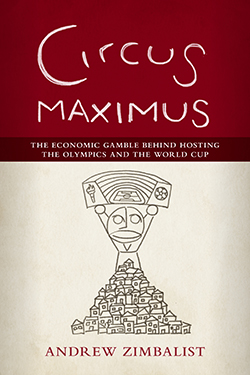 Circus Maximus: The Economic Gamble Behind Hosting the Olympics and the World Cup
Circus Maximus: The Economic Gamble Behind Hosting the Olympics and the World Cup
Andrew Zimbalist
Brookings Institution Press
Jan 14, 2015, 174 Pages
As every host knows, no matter how many bottles of wine or plates of cheese guests may bring, a party isn't likely to turn a profit. Many of the world's cities have not yet gotten this message.
For many decades, especially since the rampant success of the 1984 Los Angeles Olympics and the modest success of the Barcelona Olympics that followed in 1992, cities that have hosted the Winter and Summer Olympics and World Cup soccer matches have done so partly on the premise of both long- and short-term economic gain. If nothing else, it feels great for a city to attract the attention of the world—so it must be great, right? In Circus Maximus, economist Andrew Zimbalist says not so fast. While athletes have to prepare and perform according to exacting standards, cities that host these mega-events often fail to do even basic arithmetic.
When you spend $40 billion, as Beijing did, or $50 billion, as Sochi did, there's really no excuse. Zimbalist argues that short-term economic gains are a fantasy and long-term gains are intangible at best. Moreover, the price tags of mega-events often discounts secondary costs, like those of displacement, congestion, and the maintenance of buildings that become white elephants. It's an important message for civic leaders who are bidding for 2024 and beyond and for the planners who might have to figure out how to accommodate them in the unfortunate event that they "win."
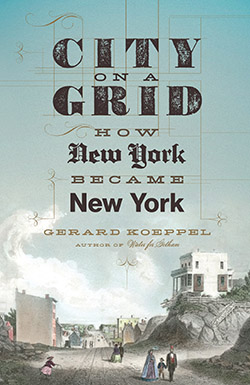 City on a Grid: How New York Became New York
City on a Grid: How New York Became New York
Gerard Koeppel
Da Capo Press
Nov 10, 2015, 336 Pages
New York City has a large number of urban obsessives—people who hoard information about the city's every block, neighborhood, street, and building. City on a Grid is a book by one of those people, and for all of those people.
City on a Grid explores, with the obsession for detail common among that particular variety of New Yorkers, the genesis of the street grid that cuts across island of Manhattan. The author, Gerard Koeppel, previously wrote a book about the Erie Canal—perhaps the only other infrastructure feature that could lay claim to such an outsized influence on the city of New York. Koeppel was surprised to discover that despite no shortage of books detailing the construction, operation, and influence of the Erie Canal, no such books yet existed for New York City's famous rectilinear grid. With such a complete telling of the grid's history of surveys, plans, politics, and designs, it could be that Koeppel has left very little for future historians of the grid to relate to readers.
The grid of New York, as the book shows, is a captivating and deeply rich subject—even from the very start. Luminaries of American history involved in the origin story of the grid include such names as L'Enfant, Roosevelt, and Burr, just to name a few.
It could also be considered a right of passage in the practice of urban design to pass judgment on the effects of the city's grid. Those who have expressed their affection for the grid include Le Corbusier, Rem Koolhaas, and Rafael Vinoly. A longer list is necessary for those who do not favor the grid, including Lewis Mumford, Fredrick Law Olmsted, Jane Jacobs, and Frank Lloyd Wright. Even such historically significant intellects as Edgar Allen Poe, Walt Whitman, Henry James, and Jean-Paul Sartre have been compelled to describe the effects of the grid. Koeppel shares the words of Roland Barthes as an example of an intellectual identifying a powerful benefit in the city's grid of streets: "This is the purpose of New York's geometry: that each individual should be poetically the owner of the capital of the world."
Much more than an exercise in waxing poetic about a mundane, yet massive, feature of New York's structure, to tell of the origin of the grid in New York City is also to tell of the origin of planning in New York City. City on a Grid therefore appeals to another kind of obsessive: people who hoard information about every city's every block, neighborhood, street, and building.
 Culture Crash: The Killing of the Creative Class
Culture Crash: The Killing of the Creative Class
Scott Timberg
Yale University Press
Jan 13, 2015, 320 pages
It's all well and good for cities to try to attract the "creative class," as Richard Florida has so often recommended. But what if the creative class can't pay its rent?
This is the troubling prospect that Scott Timberg describes in Culture Crash: The Killing of the Creative Class.
Timberg does not focus directly on cities, but that's probably because he considers their role in the creative economy to be a given. Stores are just one aspect of that relationship, albeit an important one. "Strolling, in particular, is something these shops encourage, and, when they close, they often make a neighborhood less walkable," writes Timberg. Removing a beloved store from a city block can ruin the block's appeal, "like knocking out Angelina Jolie's front tooth." The demise of the culture economy leads to "an abandonment of public spaces as well as the notion of a shared culture."
Timberg defines his cultural ideal in urban terms. He writes, "Every decent-sized city would have an array of book and record stores and performance venues as well as a good newspaper that could afford arts coverage and assertive watchdog journalism." It's arguable that these amenities should concern planners just as much as streets, sewers, and affordable housing do.
It's not like cities don't already have enough to do and too little money with which to do it. But so long as some segments of America are turning away from urbanism and art alike, the creative class offers progressive cities yet another opportunity to distinguish themselves and, quite possibly, make themselves more prosperous in the process.
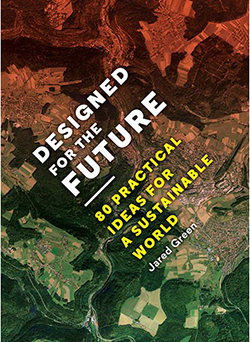 Designed for the Future: 80 Practical Ideas for a Sustainable World
Designed for the Future: 80 Practical Ideas for a Sustainable World
Jared Green
Princeton Architectural Press
April 21, 2015, 176 pages
Jared Green has used the access available in his position as the editor of The Dirt for the American Society of Landscape Architects to create a book admirable for the volume of its ideas and the accessibility of its language.
As described by the book's title, Green interviewed 80 leaders in the field of design, policy, planning, and more, for their ideas about what gives them hope for a sustainable future. Each of the ideas is, without exception, practical, as the book's title insists, but also incredibly ambitious in the aggregate.
The 80 ideas presented in the book can be found (or developed if they aren't yet found) in every corner of the world and all over the spectrums between hyper-local and global, artistic and engineered, delivered and conceptual. Throughout the book Green conducts conversations in clear and accessible language—avoiding the esoteric tendencies of the academic or design languages occasionally employed by some of those included among the book's 80 contributors.
Included among the book's stellar list of contributors are some of the most visible leaders of the professional practice of planning—Victor Dover, Paul Farmer, Jess Zimbabwe, and more. Savvy observers of the planning media landscape will also find such recognizable and accomplished figures as Anthony Flint, John King, Inga Saffron, and F. Kaid Benfield among the book's contributors.
In total, the project is inherently and ambitiously optimistic. With a promise to remain practical, the 80 ideas described in the book achieves more than perhaps expected in inspiring its readers to move forward, to build, and to plan for a sustainable future.
 Fantastic Cities: A Coloring Book of Places Real and Imagined
Fantastic Cities: A Coloring Book of Places Real and Imagined
Steve McDonald
Chronicle Books
August 11, 2015, 60 Pages
A stunning entry in the emerging and popular genre of adult coloring books, Fantastic Cities offers far more than a simple diversion for idle hands. A strong seller since its release as an outlier in the category of architecture books, the book has captured the imagination of those already immersed in the design and planning of cities. Here's hoping the book can inspire even more of the population to productively and creatively engage with their communities and the details of the built environment.
McDonald created the images included in the books from photographic sources, remaking each of images to varying degrees as something between realism and fantasy. Cities in Germany, Greenland, Canada, Japan, and the United States are included among the images ready for the coloring. Images include cars, trees, rowhouses, single-family houses, long avenues, and city blocks. Perspectives vary from aerial to architectural detail.
For evidence of the power of this book, check out #FantasticCities on Instagram, where at the time of this writing, 1,152 photos showcase imagination at work.
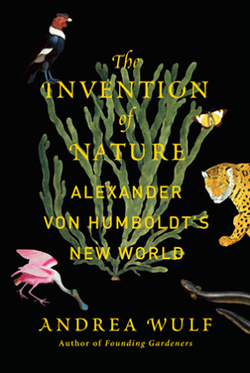 The Invention of Nature: Alexander Von Humboldt's New World
The Invention of Nature: Alexander Von Humboldt's New World
Andrea Wulf
Alfred A. Knopf
September 15, 2015, 496 pages
Alexander Von Humboldt is one of the most famous human beings to ever walk the face of the earth. And walk the face of the earth, he certainly did.
On September 14, 1869, on the centennial of Humboldt's birth, people living in cities in Europe, Africa, Australia, North America, and South America took to the streets to celebrate his name. Since that time, you might have noticed (or not noticed, as it were), Alexander Von Humboldt the man has receded from prominence, but the influence of his intelligence lives on.
Alexander Von Humboldt is no less than the forefather of environmentalism—the first to conceive of a natural world connected and intertwined like a web. As described by Andre Wulf, "He saw the world as one great living organism where everything is connected, conceiving a bold new vision of nature that still influences the way that we understand the natural world."
Thanks to the clear and animated prose of Wulf, the intelligence and adventurous spirit of Humboldt comes alive on the page. Wulf artfully traces the journeys and experiments of Humboldt's life, into conversations with people like Johann Wolfgang von Goethe, Thomas Jefferson, and Simón Bolívar, and through his influence on people like Henry David Thoreau, John Muir, and Charles Darwin.
For planners and others concerned with building a sustainable and healthy world for later generations to inherit, Humboldt's towering influence is made clear from an anecdote early in his life. Exploring the Lake Valencia area of present-day Venezuela, Humboldt concluded that deforestation had changed the climate of the area. "As Humbdolt described how humankind was changing the climate, he unwittingly became the father of the environmental movement," writes Wulf.
The reader should be warned, however, that no small amount of envy should be expected while reading this book—both for the world of Humboldt's day, with so many possibilities for exploration and discovery, and for the world of today, suffering from a lack of recognition and celebration of Humboldt's example.
Read the New York Times "Ten best Books of 2015" list.
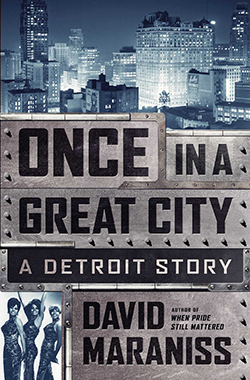 Once in a Great City: A Detroit Story
Once in a Great City: A Detroit Story
David Maraniss
Simon & Schuster
Sept 15, 2015, 464 pages
To say that David Maraniss has mastered his craft would be an understatement. Once in a Great City is a tour-de-force of journalism—a treasure trove of research and historical data animated by a prose and storytelling style that brings Detroit to life.
While Maranniss is certainly worthy of such superlative terms, surely the early 1960s era of Detroit described by this book still deserves most of the credit for the animating force found on every page of this book. As the book travels day by day, and block by block, through Detroit in the months between Fall 1962 and Spring 1964, a portrait of a cultural and industrial behemoth emerges. The drama plays out between car companies, politicians, Motown, labor unions, and more—all with careful attention to the buildings and streets where the city conducted its business. The story is as lively and as colorful and as human as the very best of what we see on the screen.
Although Detroit's decline resists comparison to the trajectory of other cities over the past 50 years, after reading Once in a Great City, it's difficult to imagine that any city now that so thoroughly and brightly embodies the promise and pitfalls of the American city as Detroit did at that time. Maybe then, it wasn't just "Detroit: Motor City" that was lost in the decades that followed—but rather the "Golden Age of American Cities."
Read the Detroit Free Press review.
 Tactical Urbanism: Short-Term Action for Long-Term Change
Tactical Urbanism: Short-Term Action for Long-Term Change
Mike Lydon and Anthony Garcia
Island Press
March 17, 2015, 256 pages
There comes a moment in the course of every nascent trend when we must ask, "is that a thing?" For tactical urbanism, that moment has been coming at least since 2008, when the (re)Bar collective deposited its first temporary minipark to inaugurate National Park(ing) Day. It's been coming since Mayor Bloomberg closed Times Square. And it's been coming since people in Los Angeles started referring to gourmet food trucks unironically. Or maybe it's been coming for a much longer time, since the days of stickball in the street, hopscotch on the sidewalk, and bartering at the crossroads.
In any event, we now can be pretty sure of the answer: yes. Tactical urbanism is indeed a thing. Tactical Urbanism: Short-term Action for Long-term Change reifies the trend once and for all. Tactical urbanism has hit the mainstream now for four reasons, according to Lydon and Garcia: shifting demographics, radical connectivity, the Great Recession, and citizen frustration. They translate to, respectively, millenials' return to center cities, the Internet and smart phones, and the high cost of development; the last one is self-explanatory.
Tactical Urbanism serves as a how-to guide for activists who want to get in on the action. There's not a lot of theorizing in Tactical Urbanism, which is probably for the best. Surely future scholars will have a field day with the trends that planners, and citizen-planners, are exploring today. Nowhere are ideas like Henri Lefebvre's "right to the city" more in question than when citizens take planning into their own hands. For now, though, everyone seems to be rolling up their sleeves and getting out the sidewalk chalk.
Read the California Planning & Development Report review.
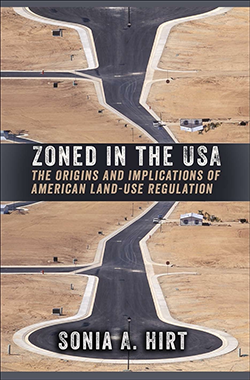 Zoned in the USA: The Origins and Implications of American Land-Use Regulation
Zoned in the USA: The Origins and Implications of American Land-Use Regulation
Sonja Hirt
Cornell University Press
Dec 4, 2014, 256 Pages
In her surprisingly rousing analysis and history of American zoning laws, Zoned in the USA, Sonja Hirt asks, essentially, why everything in the United State is so damn far away from everything else. It takes an outsider like Hirt—who is Bulgarian and therefore familiar with both European cities and governmental power—to recognize the stark differences between the control of land in American cities and that in their counterparts elsewhere in the developed world. A professor of planning at Virginia Tech, Hirt positions herself as the Alexis de Toqueville of planning, equally baffled and fascinated by the odd world that Americans have built.
Hirt grounds her inquiry in a paradox: Americans proclaim their love for freedom and private property rights, and yet they gleefully submit to "tedious laws governing the building of their everyday environments and way of life." These laws, directly and indirectly, serve a single goal: that of promoting neighborhoods dedicated to the single-family detached home.
Thought Hirt often does not hide her bafflement, Zoned in the USA is that rare book that has a perspective but not an agenda. It likewise carries the heft of research but is compelling, and convincing, enough—sometimes just barely—to be one of the more enjoyable scholarly texts on what can be a dreadfully dull topic. It's a worthy tangent to the sociological insights of Crabgrass Frontier, and a steely rejoinder to Wendell Cox, Robert Breugemann, Joel Kotkin, and other conservatives who claim that suburban sprawl merely reflects market demand. Hirt writes, "As Foucault teaches us, rules and institutions that we often take for granted are far from 'natural'; they were simply made up at some point in time."
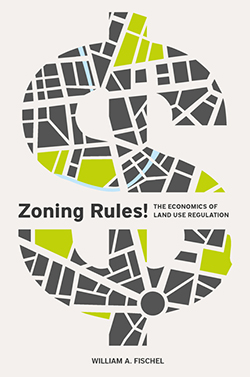 Zoning Rules!: The Economics of Land Use Regulation
Zoning Rules!: The Economics of Land Use Regulation
William A. Fischel
Lincoln Institute of Land Policy
July 10, 2015, 432 Pages
Zoning Rules! is not for the casual reader or the faint of heart. It is a dense, comprehensive analysis of something that almost defies analysis and yet "rules" every facet of American urban life: zoning. The impacts of zoning, especially its economic impacts, are elusive because zoning by definition cannot be studied with control groups. In Zoning Rules!, William Fischel does exhaustive work to determine exactly what the economic costs and benefits are of zoning regulations across the United States.
A free-market advocate, Fischel has disheartening news for the 20th century planners who followed a prescriptive, restrictive model: "State, federal, and judicial interventions to control local zoning have done more harm than good. To help grow the economy, decrease inequality, and improve the environment, America needs to take the wind out of the sails of local land use regulation." Then again, for every counterproductive market distortion that Fischel identifies, there's a young planners and a progressive city that has the chance to un-do some of the damage. These days, zoning serves mainly to prop up home values in single-family neighborhoods. For everyone else, it's a losing proposition.
Fischel calls for abolishing more than just zoning. He's also not a fan of urban growth boundaries, rent control, mortgage tax subsidies, and other influences that, he writes, keep cities from realizing their economic potential.

Planetizen Federal Action Tracker
A weekly monitor of how Trump’s orders and actions are impacting planners and planning in America.

Congressman Proposes Bill to Rename DC Metro “Trump Train”
The Make Autorail Great Again Act would withhold federal funding to the system until the Washington Metropolitan Area Transit Authority (WMATA), rebrands as the Washington Metropolitan Authority for Greater Access (WMAGA).

The Simple Legislative Tool Transforming Vacant Downtowns
In California, Michigan and Georgia, an easy win is bringing dollars — and delight — back to city centers.

The States Losing Rural Delivery Rooms at an Alarming Pace
In some states, as few as 9% of rural hospitals still deliver babies. As a result, rising pre-term births, no adequate pre-term care and "harrowing" close calls are a growing reality.

The Small South Asian Republic Going all in on EVs
Thanks to one simple policy change less than five years ago, 65% of new cars in this Himalayan country are now electric.

DC Backpedals on Bike Lane Protection, Swaps Barriers for Paint
Citing aesthetic concerns, the city is removing the concrete barriers and flexposts that once separated Arizona Avenue cyclists from motor vehicles.
Urban Design for Planners 1: Software Tools
This six-course series explores essential urban design concepts using open source software and equips planners with the tools they need to participate fully in the urban design process.
Planning for Universal Design
Learn the tools for implementing Universal Design in planning regulations.
Smith Gee Studio
City of Charlotte
City of Camden Redevelopment Agency
City of Astoria
Transportation Research & Education Center (TREC) at Portland State University
US High Speed Rail Association
City of Camden Redevelopment Agency
Municipality of Princeton (NJ)





























